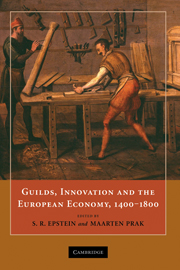Book contents
- Frontmatter
- Contents
- List of Contributors
- Acknowledgments
- Introduction: Guilds, Innovation, and the European Economy, 1400–1800
- 1 Craft Guilds, the Theory of the Firm, and Early Modern Proto-industry
- 2 Craft Guilds, Apprenticeship, and Technological Change in Pre-industrial Europe
- 3 Subcontracting in Guild-based Export Trades, Thirteenth–Eighteenth Centuries
- 4 Circulation of Skilled Labour in Late Medieval and Early Modern Central Europe
- 5 Painters, Guilds, and the Art Market during the Dutch Golden Age
- 6 Craft Guilds and Technological Change: The Engine Loom in the European Silk Ribbon Industry in the Seventeenth and Eighteenth Centuries
- 7 Guilds, Technology, and Economic Change in Early Modern Venice
- 8 Inventing in a World of Guilds: Silk Fabrics in Eighteenth-century Lyon
- 9 ‘Not to Hurt of Trade’: Guilds and Innovation in Horology and Precision Instrument Making
- 10 Reaching beyond the City Wall: London Guilds and National Regulation, 1500–1700
- 11 Guilds in Decline? London Livery Companies and the Rise of a Liberal Economy, 1600–1800
- Index
5 - Painters, Guilds, and the Art Market during the Dutch Golden Age
Published online by Cambridge University Press: 24 June 2009
- Frontmatter
- Contents
- List of Contributors
- Acknowledgments
- Introduction: Guilds, Innovation, and the European Economy, 1400–1800
- 1 Craft Guilds, the Theory of the Firm, and Early Modern Proto-industry
- 2 Craft Guilds, Apprenticeship, and Technological Change in Pre-industrial Europe
- 3 Subcontracting in Guild-based Export Trades, Thirteenth–Eighteenth Centuries
- 4 Circulation of Skilled Labour in Late Medieval and Early Modern Central Europe
- 5 Painters, Guilds, and the Art Market during the Dutch Golden Age
- 6 Craft Guilds and Technological Change: The Engine Loom in the European Silk Ribbon Industry in the Seventeenth and Eighteenth Centuries
- 7 Guilds, Technology, and Economic Change in Early Modern Venice
- 8 Inventing in a World of Guilds: Silk Fabrics in Eighteenth-century Lyon
- 9 ‘Not to Hurt of Trade’: Guilds and Innovation in Horology and Precision Instrument Making
- 10 Reaching beyond the City Wall: London Guilds and National Regulation, 1500–1700
- 11 Guilds in Decline? London Livery Companies and the Rise of a Liberal Economy, 1600–1800
- Index
Summary
Introduction
Over the past few decades the historiography of craft guilds has changed dramatically, as historians have realised that the rules and regulations that had formerly underpinned writing about guilds were not necessarily adhered to in practice. This has resulted in a double reorientation of the historiography. On the one hand, many historians of the guilds have construed the inconsistencies between practices and norms as evidence of ‘flexibility’. On the other hand, they have de-emphasised the economic impact of the craft guilds, in favour of their social and cultural contributions to the shaping of medieval and early modern European society. The upshot of this reorientation has been that guilds have been declared irrelevant in the economic domain where they were traditionally perceived to be most significant. Much of the recent literature, however, covers broad swathes of the pre-modern economy and lumps together evidence from a wide variety of trades, which did not necessarily follow the same rules and dynamics. To diminish the potential dangers of this approach, this chapter focuses on a single trade during a relatively brief span of time.
The arts are a particularly attractive sector for pre-modern economic historians for two reasons. First, since artists signed their products and since those products were generally durable, it is possible to trace details over time about sales, prices, and so on for individual paintings, and at times even for sculpture and silverware.
- Type
- Chapter
- Information
- Guilds, Innovation and the European Economy, 1400–1800 , pp. 143 - 171Publisher: Cambridge University PressPrint publication year: 2008
- 6
- Cited by



